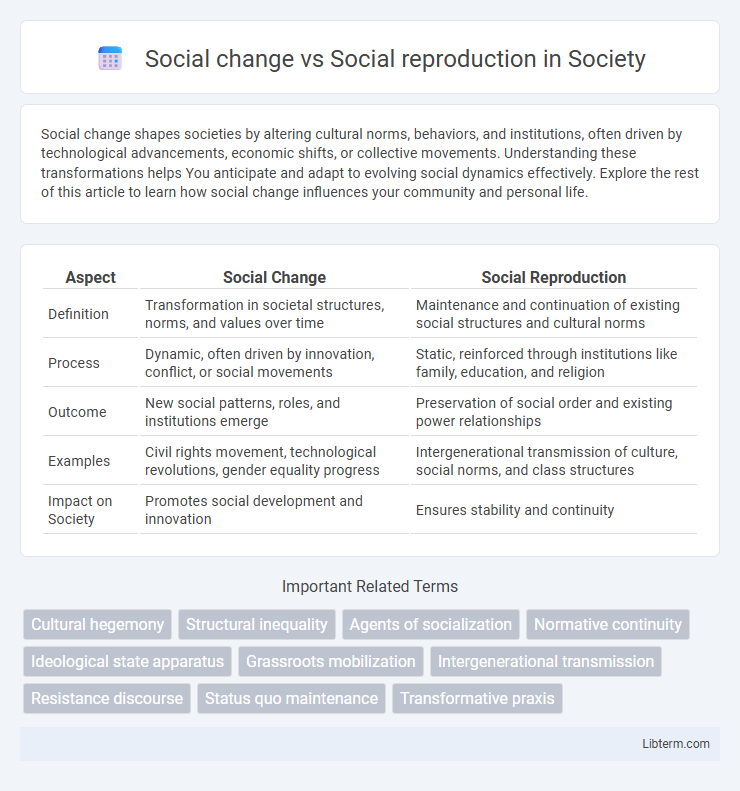Social change shapes societies by altering cultural norms, behaviors, and institutions, often driven by technological advancements, economic shifts, or collective movements. Understanding these transformations helps You anticipate and adapt to evolving social dynamics effectively. Explore the rest of this article to learn how social change influences your community and personal life.
Table of Comparison
| Aspect | Social Change | Social Reproduction |
|---|---|---|
| Definition | Transformation in societal structures, norms, and values over time | Maintenance and continuation of existing social structures and cultural norms |
| Process | Dynamic, often driven by innovation, conflict, or social movements | Static, reinforced through institutions like family, education, and religion |
| Outcome | New social patterns, roles, and institutions emerge | Preservation of social order and existing power relationships |
| Examples | Civil rights movement, technological revolutions, gender equality progress | Intergenerational transmission of culture, social norms, and class structures |
| Impact on Society | Promotes social development and innovation | Ensures stability and continuity |
Understanding Social Change: Definition and Key Concepts
Social change refers to the significant transformation over time in cultural, economic, political, and social institutions, driven by factors such as technological innovation, social movements, and demographic shifts. Key concepts include structural change, which alters societal frameworks, and agency, highlighting individuals' and groups' roles in shaping progress. This contrasts with social reproduction, the processes by which societies maintain stability and continuity through norms, values, and social institutions.
Exploring Social Reproduction: Meaning and Mechanisms
Social reproduction refers to the processes through which societies maintain and perpetuate existing social structures, norms, and inequalities across generations. Key mechanisms include family socialization, education systems, and economic institutions that transmit cultural capital, social norms, and resources. Examining these mechanisms reveals how social roles and power dynamics are sustained, ensuring continuity despite external changes.
Historical Perspectives on Social Change vs Social Reproduction
Historical perspectives on social change emphasize transformative shifts in social structures, norms, and institutions driven by movements, revolutions, and economic developments. Social reproduction, in contrast, focuses on the mechanisms through which existing social orders, such as class hierarchies and cultural practices, are maintained and transmitted across generations. Scholars like Karl Marx and Emile Durkheim analyze social change as a dynamic process, whereas social reproduction theories highlight stability and resilience within societies over time.
Drivers of Social Change in Contemporary Society
Technological innovation, globalization, and social movements serve as primary drivers of social change in contemporary society, reshaping cultural norms, economic structures, and power dynamics. Advances in digital communication technologies enable rapid dissemination of ideas, catalyzing collective action and transforming social institutions. Economic shifts, such as automation and changing labor markets, challenge traditional systems of social reproduction, prompting adaptation within families, education, and community networks.
Institutions and the Role of Social Reproduction
Institutions play a critical role in social reproduction by sustaining established norms, values, and power structures that preserve societal continuity over time. Social reproduction involves the transmission of cultural capital, social roles, and economic resources across generations, reinforcing existing hierarchies within education, family, and labor institutions. In contrast, social change disrupts these patterns by transforming institutional frameworks and challenging entrenched social practices.
Power, Inequality, and Social Structure
Social change transforms power dynamics by challenging existing inequalities and reshaping social structures, often redistributing resources and altering institutional norms. Social reproduction, in contrast, perpetuates established power relations by maintaining social hierarchies and reinforcing systemic inequalities through traditions and routine practices. Both concepts interconnect, with social reproduction sustaining the status quo while social change disrupts entrenched social frameworks.
Education: Catalyst for Change or Agent of Reproduction?
Education serves as a catalyst for social change by promoting critical thinking, innovation, and equitable access to opportunities, thereby challenging existing social hierarchies. Conversely, it functions as an agent of social reproduction by perpetuating class structures and reinforcing cultural norms through standardized curricula and unequal resource distribution. Understanding this dual role is essential for framing education policies that either disrupt or sustain societal inequalities.
Social Movements: Challenging the Status Quo
Social movements serve as critical agents of social change by challenging dominant norms, policies, and power structures that perpetuate inequality and injustice. These collective efforts mobilize marginalized groups to disrupt social reproduction, which typically maintains existing social hierarchies through cultural, economic, and institutional mechanisms. By advocating for transformative reforms, social movements catalyze shifts in societal values, laws, and practices that redefine social relations and promote equity.
Policy Implications: Balancing Change and Stability
Policy implications of social change versus social reproduction demand a strategic balance between fostering innovation and preserving societal stability. Emphasizing social change drives reforms in education, healthcare, and economic policies that promote equity and inclusion, while social reproduction necessitates policies that maintain existing social structures, cultural norms, and intergenerational knowledge transfer. Effective policymaking integrates mechanisms to support progressive transformation without disrupting core social institutions vital for continuity and cohesion.
Future Directions: Navigating Social Change and Reproduction
Future directions in navigating social change and social reproduction emphasize balancing innovation with the preservation of cultural values and social structures. Strategies include leveraging technology and education to promote equitable social mobility while maintaining intergenerational continuity. Policy frameworks must address systemic inequalities to facilitate adaptive social transformation without compromising social cohesion.
Social change Infographic

 libterm.com
libterm.com